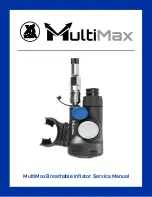
THE HAMMOND VIBRATO
PRINCIPLE OF OPERATION
The vibrato effect is created by a periodic raising and lowering of pitch, and thus is fundamentally different
from a tremolo, or loudness variation. It is comparable to the effect produced when a violinist moves his
finger back and forth on a string while playing, varying the frequency while maintaining constant volume.
The Hammond Organ vibrato equipment (see simplified block diagram,
) varies the frequency of all
tones by continuously shifting their phase. It includes a phase shift network or electrical time delay line,
composed of a number of low pass filter sections, and a capacity type pickup or scanner, which is motor
driven so that it scans back and forth along the line.
Electrical waves fed into the line are shifted in phase by each line section (the amount per section being
proportional to frequency), so that at any tap on the line the phase is retarded relative to the previous tap.
The scanning pick-up traveling along the line will thus encounter waves increasingly retarded in phase at
each successive tap, and the signal it picks up will continuously change in phase. The rate at which this
phase shift occurs will depend on how many line sections are scanned each second.
Since a cycle is equivalent to 360 electrical degrees, a frequency shift of one cycle occurs for each 360
electical degrees scanned per second. For example if the scanner passes over the line at such a rate that
3600 electrical degrees are scanned each second, there will be a frequency change of 10 cycles.
For the widest vibrato, the whole line is scanned from beginning to end in about 1/14 second, and this rate of
change of phase causes about 1-1/2% decrease in frequency. Note that the frequency remains constantly 1-
1/2% low as long as the moving pick-up retards the phase at a constant rate.
Since the pick-up sweeps from start to end of the line and then back, it increases the frequency by an equal
percentage on its return trip, the average output frequency remaining equal to the input frequency. The exact
amount of frequency shift depends not only on the amount of phase shift in the line but also on the scanning
rate. This rate, however, is constant because the scanner is driven by the synchronous running motor of the
organ.
The degree of vibrato (or amount of frequency shift) may be varied by a switch (not shown in Fig. 25) which
causes the whole line to be scanned for #3 (wide) vibrato, about half of it, for #2, and about one third for #1.
A vibrato chorus effect, similar to the effect of two or three slightly out-of-tune frequencies mixed together, is
obtained when the vibrato output signal is mixed with a portion of signal without vibrato. For vibrato chorus,
part of the incoming signal appears across the vibrato line and the rest across a resistor in series with the
line. As the vibrato effect is applied to the part of the signal appearing across the line, but not to the part
appearing across the resistor, the combination produces a chorus effect. For normal vibrato, this resistor is
short-circuited
CONSTRUCTION OF COMPONENTS
Figure 26 shows the vibrato line box.
Each of the inductance coils, with a capacitor, forms one filter section.
21
tuttotastiere.com





































